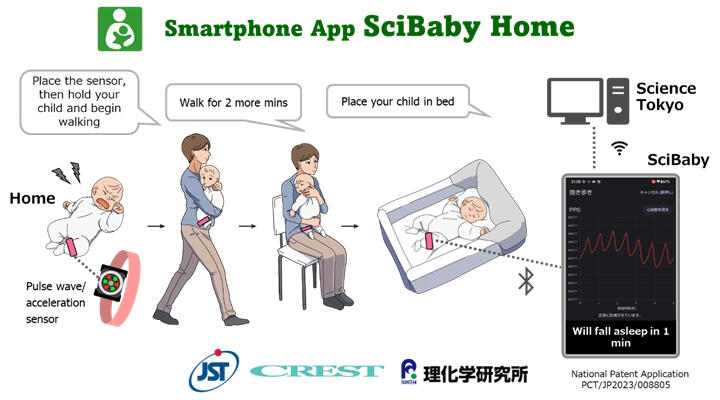On February 21, a joint research group led by Professor Kumi Kuroda and Researcher Kento Harachi of the Department of Life Science and Technology, School of Life Science and Technology, Institute of Science Tokyo, and Professor Natsue Yoshimura of the Department of Computer Science, School of Computing at the Institute of Science Tokyo, has announced that they developed "SciBaby," a research smartphone app that provides scientific assistance for infant sleep and crying problems. The app provides audio guidance on the effective carrying and laydown timing based on scientific evidence. An infant's natural sleep is induced by first carrying them for 5 minutes, followed by sitting and holding them (https://www.scibaby.org/). The Android version of the app is now available for download on Google Play. The iOS version is also under development.

Provided by Science Tokyo
Infants up to one year of age cry a lot, and this can cause parental stress, which triggers child maltreatment in a small number of cases. Various methods have been used in different cultures to promote infant sleep, including giving them piggyback rides and carrying them in the arms or a stroller while walking. However, a surprisingly small number of studies have scientifically examined the effectiveness of these methods.
In 2013, the Kuroda Laboratory discovered the "transport response" in mice pups and human infants as a phenomenon in which a baby is soothed by being held in the arms of a walking parent. Because parents of wild animals carry their children mostly in dangerous situations where foreign enemies are present, the transport response has been considered a mechanism to gain a survival advantage by soothing the children immediately while they are being carried. In 2022, they also found that 5-minute continuous carrying induces sleep in nearly half of crying infants.
This study showed the possibility that better timing for sleep induction could be determined by measuring the infant's heart rate, pulse, and other conditions. At the time, these parameters were measured with a hospital-grade electrocardiograph and thus difficult to measure at home.
To address this issue, the research group developed "SciBaby," a measurement system that uses wearable sensors and a smartphone. After installing the app, users log in with their Google account credentials and consent to participate in the study before they can start to use it. When the infant is fussy or crying, a user activates the app's "carrying mode" and puts a wristwatch-type pulse sensor on the infant. SciBaby establishes a Bluetooth connection with the sensors and records the infant's condition. This mode can also be used without the sensors.
Three hundred trials in 30 infants showed that 84.4% of crying infants stopped crying during a 5-minute carrying period, and 58.4% fell asleep during the subsequent 8-minute sitting and holding period. However, about 20% of the sleeping infants woke up when they were laid in a bed. The research group is currently conducting research to predict the optimal timing for the laydown using machine learning and other methods.
Kuroda said, "Baby crying and sleep problems, such as nighttime and twilight crying, have been known for a long time, but they have not been studied scientifically. We wanted to use recent technological advances for childcare, so we created 'SciBaby,' an app that uses the data from wearable sensors to promote an infant's sleep while carrying the infant in the arms. A trick is to walk steadily at a constant pace for 5 minutes, even if the baby is crying, as if you were walking to the station, rather than doing it to soothe the baby. Another trick is not to walk fast but with small strides, keeping your usual number of steps. Give it a try!"
■ This smartphone app was developed with funding from JST's CREST Program
This article has been translated by JST with permission from The Science News Ltd. (https://sci-news.co.jp/). Unauthorized reproduction of the article and photographs is prohibited.




